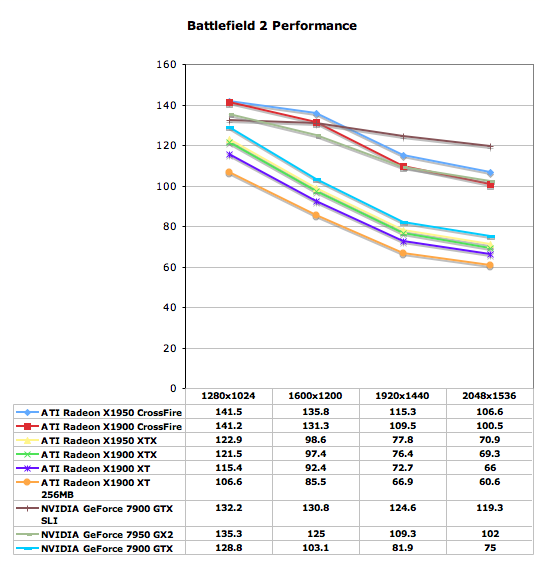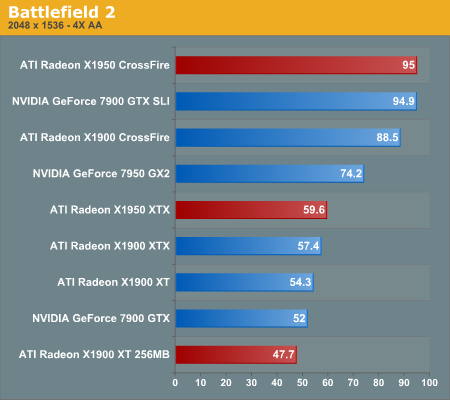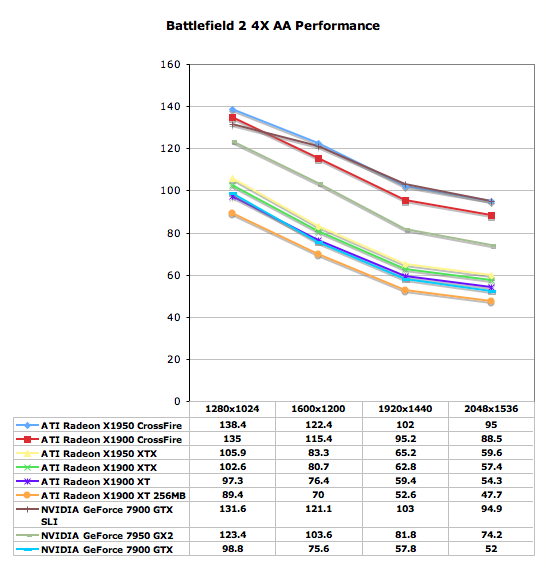ATI's New High End and Mid Range: Radeon X1950 XTX & X1900 XT 256MB
by Derek Wilson on August 23, 2006 9:52 AM EST- Posted in
- GPUs
Battlefield 2 Performance
This benchmark is performed using DICE's built in demo playback functionality with a few added extras built in house. When using the built in demo playback features of BF2, frames rendered during the loading screen are counted in the benchmark. In order to get a real idea of performance, we use the instantaneous frametime and frames per second data generated from a benchmark run. We discard the data collected during the loading screen and calculate a result that represents the actual gameplay that was benchmarked. While DICE maintains that results over 100fps aren't reliable, our methods have allowed us to get useful data from high performing systems.
During the benchmark, the camera switches between players and vehicles in order to capture the most action possible. There is a lot of smoke and explosions, so this is a very GPU intensive Battlefield 2 benchmark. The game itself is best experienced with average in-game framerates of 35 and up.
We ran Battlefield 2 using the highest quality graphics settings we could. Shadows, lighting, and especially view distance are very important in order to best play the game. In our opinion view distance should never be set to less than the max, but other settings can be decreased slightly if a little more performance or a higher resolution is required.

At the very top of the charts the GeForce 7900 GTX SLI manages to maintain just under a 12% advantage over the X1950 CrossFire, indicating to NVIDIA that it may not need to even respond with a new product to combat ATI's launch today at the high end. A single 7950 GX2 offers virtually identical performance to the X1950 CrossFire, showcasing the main strength of the 7950 GX2: its ability to offer dual card performance in a single slot in any platform. The performance advantage the X1950 CrossFire offers over its X1900 predecessor is 6%, definitely not enough to warrant an upgrade.
Single card performance is representative of what we've seen with multi-GPU performance, with the single 7900 GTX outperforming a single X1950 XTX. Note that the 7900 GTX's performance advantage actually grows from one to two cards, thanks to better scaling with NVIDIA's SLI architecture over ATI's CrossFire.
At the very bottom of the chart we've got the X1900 XT 256MB which really puts things into perspective. Being able to deliver 60 fps at 2048 x 1536 itself, most users will be monitor limited before they are GPU limited in games like Battlefield 2; in which case, the clear recommendation here is the $280 X1900 XT (or the similarly priced factory overclocked 7900 GT as we saw earlier in this review).

Although the 7900 GTX SLI performs better at higher resolutions, ATI's X1950 and X1900 CrossFire setups actually perform better at lower, more CPU bound resolutions, indicating greater driver overhead with NVIDIA's SLI. CPU limitations are quite evident at lower resolutions with the multi-GPU setups further reinforcing the idea that if you've got a LCD with a 1280 x 1024 maximum resolution, then you may want to think twice about upgrading to a second GPU.
The CPU limitations seen at 1280 x 1024 start to fade away as we move to 1600 x 1200, where the multi-GPU pack separates itself from the single GPU cards. What's interesting is that, with the exception of NVIDIA's 7900 GTX SLI, the remaining multi-GPU cards have similar resolution scaling curves to the single cards, just at higher frame rates.

When AA gets kicked on, we see the numbers get shaken up a bit. X1950 CrossFire essentially ties 7900 GTX SLI for the performance lead, and the 7950 GX2 drops to the bottom of the multi-GPU pile. Single GPU performance becomes dominated by ATI cards with the 7900 GTX falling to nearly the level of the 256MB X1900 XT. At the same time, it is a nice treat to realize that even the 256MB X1900 XT is playable at 2048x1536 with all the eye candy cranked up.

Our scaling graph doesn't show the same CPU limitedness we saw without AA enabled. The 7900 GTX SLI does see a hint of performance loss due to driver overhead here as well, but otherwise all these cards scale similarly as in the previous test.










74 Comments
View All Comments
nextsmallthing - Wednesday, August 23, 2006 - link
Did anyone else notice that the specs for some of the NVIDIA cards are wrong? For example, the core clock of the 7900GTX is supposed to be 650 MHz, not 700 MHz, and the core clock of the 7900GT should be 450 MHz, not 470 MHz. Also, the pipeline configuration for the 7300GT (according to Wikipedia anyway) should be 8 pixel & 4 vertex.This many mistakes really makes me question the accuracy of other specs I read on Anandtech.
(And by the way, would somebody please inform the DailyTech writers that it's "Xbox 360", not "XBOX 360". And yes I'm aware of the conventions that punctuation goes inside quotes and you shouldn't start sentences with "and".)
Anand Lal Shimpi - Wednesday, August 23, 2006 - link
The 7900GTX/GT clock speeds that were listed were actually vertex clock speeds, not general core clock speeds, so they were technically correct (parts of the GPU do run at those frequencies) just not comparable to the other numbers. They have been corrected.The 7300GT is indeed 8 pipes, that was a copy/paste error. Thanks for the heads up.
Take care,
Anand
nextsmallthing - Thursday, August 24, 2006 - link
Wow--prompt correction and courteous reply. I'm impressed, and my faith in Anandtech is restored!Josh7289 - Wednesday, August 23, 2006 - link
From the looks of the pricing structure for ATI's cards on the first page, and especially from the looks of the pricing structure for ATI's cards after they simplify their lineup, it looks like ATI is giving up on midrange cards, from $100 - $200. The 7600GT and the upcoming 7900GS both are alone in that price range (about $150 and $200, respecitively), with no competition from ATI, so it seems they really are giving that price range to Nvidia.Am I right with this or am I seriously missing something?
yyrkoon - Wednesday, August 23, 2006 - link
there is a x1800GTO2, price last I looked was around $230, of course, they released it rather quietly. Still, thats about $90 higher than the 7600 GT (or in my case the eVGA 7600GT KO).OrSin - Wednesday, August 23, 2006 - link
I wondering the same thing. Are they going to stop making any 1800's. They should be dropping in this price range nicely. Not sure how competative they are with the 7900's. And now that the 7900GS is coming out the 1800 might be just too outclassed. (you guys just missed a great deal on woot 7900GS for $145).I hope 1800 drop is still being made and I hope it drops to $150-180 range to fill that gap.
JarredWalton - Wednesday, August 23, 2006 - link
I think they've already stopped making all of the X1800 series, but there are still cards floating around.Josh7289 - Wednesday, August 23, 2006 - link
The X1900GT is a card meant to compete with the stock 7900GT, and as such is somewhere around the $200 - $250 price range.As for the X1950 Pro and X1650 XT, what are these supposed to compete against and at what prices. More importantly, when are these supposed to launch?
coldpower27 - Wednesday, August 23, 2006 - link
As well the X1650 XT is also in the works.coldpower27 - Wednesday, August 23, 2006 - link
X1950 Pro, is upcoming, as well they still have the X1900 GT.